Intraoral Injuries (Injuries inside the mouth)
Blunt trauma or a fall may precipitate intraoral injuries. Often children are the victims of such injuries. Occasionally a pencil or toothbrush or a stick and even sharp ends of a toy that is placed in the mouth may cause injury. Such injuries cause simple lacerations, cuts or tears in the mouth and may even cause serious injuries.
Large scale injuries will cause swelling that may choke the airway for breathing. Hence it is prudent that a medical or a dental examination need to be performed. In case troubled breathing is expected, a procedure called tracheostomy has to be performed on an emergency basis to ensure patency of the airway.
-
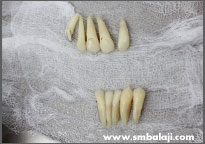
Avulsed teeth that were brought along with the patient after he met with a vehicular accident
-
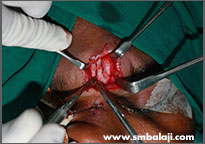
Forehead fracture being treated
-
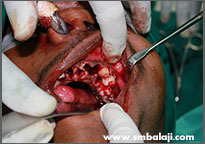
Upper jaw with empty sockets
-
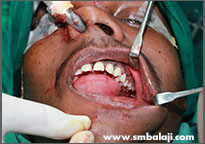
Avulsed teeth inserted in their respective sockets
-
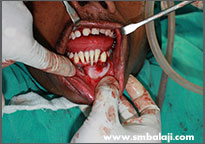
Teeth inserted in the lower jaw sockets
-

Upper jaw with empty sockets
-
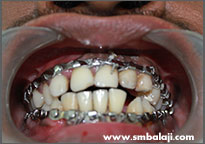
Fixation of teeth done for stability
-
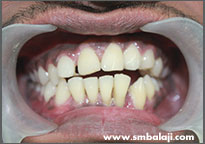
Postoperative view of well stabilised teeth
Cuts or damage to the palate (the roof of mouth) readily bleeds but spontaneous healing ensures. Cuts or injuries of tongue bleed heavily and require medical help. Slightly large cuts may require stitches and medical management. Deep injuries need surgical attention as the musculature is often delicate and careful handling is needed. Sometimes incision needs to be placed for removal of foreign materials. Careful manipulation is required to prevent formation of scars that could potentially interfere with tongue movements (for speech and chewing) as well as taste sensation.
Shown here are photographs of a patient who had a severe fall and lost his upper and lower front teeth. He reported to Balaji Dental and Craniofacial Hospital bringing his avulsed teeth with him. He also had a fracture of his forehead bone.
In some cases of trauma, both the right and left condyle may be fractured and displaced. In such instances, the patient’s occlusion or contact between upper and lower teeth gets deranged. The fracture site is surgically exposed, the fractured segments are stabilized and fixed with bone plates. This is done only after accurately restoring the patient’s occlusion.
